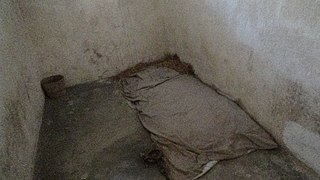Related Research Articles
Prison sexuality consists of sexual relationships between prisoners or between a prisoner and a prison employee or other persons to whom prisoners have access. Since prisons are usually separated by sex, most sexual activity is with a same-sex partner. Exceptions to this include sex with spouses/partners during conjugal visits and sex with a prison employee of the opposite sex.

The Mississippi Department of Corrections (MDOC) is a state agency of Mississippi that operates prisons. It has its headquarters in Jackson. As of 2020 Burl Cain is the commissioner.

Incarceration in the United States is one of the primary means of punishment for crime in the United States. In 2023, over five million people are under supervision by the criminal justice system, with nearly two million people incarcerated in state or federal prisons and local jails. The United States has the largest known prison population in the world. Prison populations grew dramatically beginning in the 1970s, but began a decline around 2009, dropping 25% by year-end 2021.
Prison rape commonly refers to the rape of inmates in prison by other inmates or prison staff. In 2001, Human Rights Watch estimated that at least 4.3 million inmates had been raped while incarcerated in the United States. A United States Department of Justice report, Sexual Victimization in Prisons and Jails Reported by Inmates, states that "In 2011–12, an estimated 4.0% of state and federal prison inmates and 3.2% of jail inmates reported experiencing one or more incidents of sexual victimization by another inmate or facility staff in the past 12 months or since admission to the facility, if less than 12 months." However, advocates dispute the accuracy of the numbers, saying they seem to under-report the real numbers of sexual assaults in prison, especially among juveniles.
Turner v. Safley, 482 U.S. 78 (1987), was a U.S. Supreme Court decision involving the constitutionality of two Missouri prison regulations. One of the prisoners' claims related to the fundamental right to marry, and the other related to freedom of speech. The court held that a regulation preventing inmates from marrying without permission violated their constitutional right to marry because it was not logically related to a legitimate penological concern, but a prohibition on inmate-to-inmate correspondence was justified by prison security needs.

Prisoner abuse is the mistreatment of persons while they are under arrest or incarcerated. Prisoner abuse can include physical abuse, psychological abuse, sexual abuse, torture, or other acts such as refusal of essential medication, and it can be perpetuated by either fellow inmates or prison faculty.

The New York State Department of Corrections and Community Supervision (NYSDOCCS) is the department of the New York State government that maintains the state prisons and parole system. The New York State prison system encompasses 44 prisons funded by the state government. This does not include other jails and prisons in New York State such as federal prisons, New York City jails, or county jails.
Beard v. Banks, 548 U.S. 521 (2006), was a case decided by the United States Supreme Court in which the petitioner, Ronald Banks, challenged the constitutionality of the Pennsylvania Department of Corrections policy of denying access to written material such as newspapers and magazines, to violent inmates, on the grounds that the policy was a violation of his First Amendment rights, including freedom of speech.
Jailhouse Jesus is the colloquial term for an observed psychological phenomenon of new inmates to 'find religion' during their incarceration. Whether it comes from a genuine desire to "repent", an appeal to authority, or other factors is a subject for debate.

Lesbian, gay, bisexual, transgender and queer (LGBTQ) people face difficulties in prison such as increased vulnerability to sexual assault, other kinds of violence, and trouble accessing necessary medical care. While much of the available data on LGBTQ inmates comes from the United States, Amnesty International maintains records of known incidents internationally in which LGBTQ prisoners and those perceived to be lesbian, gay, bisexual or transgender have suffered torture, ill-treatment and violence at the hands of fellow inmates as well as prison officials.
Farmer v. Brennan, 511 U.S. 825 (1994), was a case in which the Supreme Court of the United States ruled that a prison official's "deliberate indifference" to a substantial risk of serious harm to an inmate violates the cruel and unusual punishment clause of the Eighth Amendment. Farmer built on two previous Supreme Court decisions addressing prison conditions, Estelle v. Gamble and Wilson v. Seiter. The decision marked the first time the Supreme Court directly addressed sexual assault in prisons.
Jones v. North Carolina Prisoners' Labor Union, 433 U.S. 119 (1977), was a United States Supreme Court case where the court held that prison inmates do not have a right under the First Amendment to join labor unions.

As of 2013, across the world, 625,000 women and children were being incarcerated in correctional facilities, and the female prison population was increasing in all continents. The list of countries by incarceration rate includes a main table with a column for the historical and current percentage of prisoners who are female.

The incarceration of women in the United States refers to the imprisonment of women in both prisons and jails in the United States. There are approximately 219,000 incarcerated women in the US according to a November 2018 report by the Prison Policy Initiative, and the rate of incarceration of women in the United States is at a historic and global high, with 133 women in correctional facilities per every 100,000 female citizens. The United States is home to just 4% of the world's female population, yet the US is responsible for 33% of the entire world's incarcerated female population. The steep rise in the population of incarcerated women in the US is linked to the complex history of the war on drugs and the US's prison–industrial complex, which lead to mass incarceration among many demographics, but had particularly dramatic impacts on women and especially women of color. However, women made up only 10.4% of the US prison and jail population, as of 2015.

In the United States penal system, upwards of 20 percent of state and federal prison inmates and 18 percent of local jail inmates are kept in solitary confinement or another form of restrictive housing at some point during their imprisonment. Solitary confinement (sometimes euphemistically called protective custody, punitive segregation (PSEG) or room restriction) generally comes in one of two forms: "disciplinary segregation," in which inmates are temporarily placed in solitary confinement as punishment for rule-breaking; and "administrative segregation," in which prisoners deemed to be a risk to the safety of other inmates, prison staff, or to themselves are placed in solitary confinement for extended periods of time, often months or years.
The use of shackles or restraints on pregnant women is a common practice in prisons and jails in the United States. Shackling is defined as "using any physical restraint or mechanical device to control the movement of a prisoner's body or limbs, including handcuffs, leg shackles, and belly chains". For females, shackles or handcuffs are placed around the ankles, wrists, or around the stomach. The shackling of pregnant women occurs while they are transported within a facility, transported to a hospital, and/or during and after childbirth. Restraints are also used on detained pregnant women in immigration detention facilities.
Prisoners in New Zealand are afforded numerous, but not all, human rights. Criticisms by a United Nations report in 2014 highlighted various issues that constitute ill-treatment of prisoners, such as remand prisoners being routinely held on lock-down for 19 hours per day, an increasingly strict prison regime, and the mixing of adult and youth prisoners.
In the United States, prisons are obligated to provide health care to prisoners. Such health care is sometimes called correctional medicine. In women's prisons, correctional medicine includes attention to reproductive health.

The August Rebellion was an uprising on August 29, 1974, at the Bedford Hills Correctional Facility for Women, a New York State prison in Bedford Hills in the Town of Bedford, Westchester County, New York, United States. In August 1974, about 200 women imprisoned at Bedford Hills rebelled, taking over parts of the prison, in protest of the inhumane treatment of Carol Crooks. A subsequent civil-action lawsuit, ruled in the inmates' favor, led to greater protections of Fourth Amendment rights for incarcerated people.
Hudson v. Palmer, 468 U.S. 517 (1984), is a United States Supreme Court case in which the Court held that prison inmates have no privacy rights in their cells protected by the Fourth Amendment to the United States Constitution. The Court also held that an intentional deprivation of property by a state employee "does not violate the Fourteenth Amendment if an adequate postdeprivation state remedy exists," extending Parratt v. Taylor to intentional torts.
References
- 1 2 Rhodes, Lorna A. (2001-10-01). "Toward an Anthropology of Prisons". Annual Review of Anthropology. 30 (1): 65–83. doi:10.1146/annurev.anthro.30.1.65. ISSN 0084-6570.
- ↑ Kaeble, Danielle; et al. (2016). "Correctional Populations in the United States, 2015" (PDF). Bureau of Justice Statistics: 1–20.
- 1 2 3 "NCJRS Abstract - National Criminal Justice Reference Service". www.ncjrs.gov. Retrieved 2018-04-11.
- 1 2 3 4 5 6 7 Miller, Teresa A. (2001). "Keeping the Government's Hands Off Our Bodies: Mapping a Feminist Legal Theory Approach to Privacy in Cross-Gender Prison Searches". Buffalo Criminal Law Review. 4 (2): 861–889. doi:10.1525/nclr.2001.4.2.861. JSTOR 10.1525/nclr.2001.4.2.861.
- ↑ Foucault, Michel (1995). Discipline and Punish: The Birth of Prisons. New York: Random House, Inc. pp. 190–229.
- 1 2 3 4 5 6 7 8 9 10 11 Barry, Fox M. (1972). "First Amendment Rights of Prisoners". Criminal Law Criminology and Police Science. 63 (2): 162–184. doi:10.2307/1142297. JSTOR 1142297.
- 1 2 3 4 5 Giles, Cheryl Dunn (1993). "Turner v. Safely and its Progeny: A Gradual Retreat to the Hands- Off Doctrine". Arizona Law Review. 35: 219–236.
- 1 2 3 Vogelman, Richard P. (1968). "Prison Restrictions. Prisoner Rights". The Journal of Criminal Law, and Police Science. 59 (3): 386–396. doi:10.2307/1141762. JSTOR 1141762.
- 1 2 3 4 Spearlt (2013-01-25). "Facts and Fictions about Islam in Prison: Assessing Prisoner Radicalization in Post-9/11 America". Institute for Social Policy and Understanding (ISPU). Retrieved 2020-07-08.
- 1 2 CTR Vantage (November 20, 2009). "The Darul Islam Movement in the United States". Foundation for Defense of Democracies. Retrieved 2020-12-25.
- ↑ Chase, Robert (2019). We Are Not Slaves: State Violence, Coerced Labor, and Prisoners' Rights in Postwar America. University of North Carolina Press. p. 191. ISBN 9781469653587.
- 1 2 3 4 5 C., Goring, Darlene (1984). "Fourth Amendment--Prison Cells: Is there a Right to Privacy". Journal of Criminal Law and Criminology. 75 (3): 609–629. doi:10.2307/1143635. JSTOR 1143635.
{{cite journal}}: CS1 maint: multiple names: authors list (link) - ↑ Reisner, S.L. (1978). "Balancing inmates' right to privacy with equal employment for prison guards". Women's Rights Law Reporter. 4: 243–251.
- 1 2 3 4 5 6 7 8 9 Ingram, John Dwight (2000). "Prison Guards and Inmates of Opposite Genders: Equal Employment Opportunities versus Right of Privacy". Gender Law and Policy. 3: 3–27 – via Hein Online.
- 1 2 3 4 5 6 7 8 Miller, Teresa A. (2000). "Sex & Surveillance: Gender, Privacy & the Sexualization of Power in Prison". Rochester, NY. SSRN 1739087.
{{cite journal}}: Cite journal requires|journal=(help) - ↑ Calhoun, Emily (1977). "The Supreme Court and the Constitutional Rights of Prisoners". Hastings Constitutional Law Quarterly. 4: 219–248.
- 1 2 3 4 5 Black, Carol F. (2010). "Doing Gender from Prison: Male Inmates and their Supportive Wives and Girlfriends". Race, Gender & Class. 17 (3/4): 255–271. JSTOR 41674764.
- 1 2 Singer, Richard G. (1972). "Privacy, Autonomy, and Dignity in the Prison: A Preliminary Inquiry Concerning Constitutional Aspects of the Degradation Process in Our Prisons". Buffalo Law Review. 21: 669–716.
- 1 2 3 4 5 6 Barraza, Leila; Collmer, Veda; Meza, Nick; Penunuri, Kristin (July 2015). "The Legal Implications of HIPAA Privacy and Public Health Reporting for Correctional Facilities". Journal of Correctional Health Care. 21 (3): 213–221. doi:10.1177/1078345815585050. ISSN 1940-5200. PMID 25953838. S2CID 206672023.
- 1 2 3 4 5 Maschke, Karen J. (1996). "Gender in the Prison Setting". Women & Criminal Justice. 7 (2): 23–42. doi:10.1300/J012v07n02_03.
- ↑ Tankersley, Sarah (1996). "Reproductive Freedom: Abortion Rights of Incarcerated and Non-Incarcerated Women". Kentucky Law Journal. 85: 219–242.
- 1 2 3 Hatton, Diane C.; Kleffel, Dorothy; Fisher, Anastasia A. (2006). "Prisoners' perspectives of health problems and healthcare in a US women's jail". Women & Health. 44 (1): 119–136. doi:10.1300/J013v44n01_07. ISSN 0363-0242. PMID 17182530. S2CID 28785893.